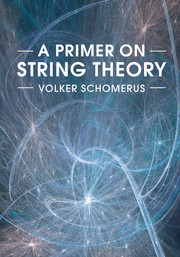Book contents
- Frontmatter
- Contents
- Preface
- 1 Historical Introduction and Overview
- Part I Strings in Flat Backgrounds
- Part II Strings in Curved Backgrounds
- 13 Introduction to Conformal Field Theory
- 14 Modular Invariants and Orbifolds
- 15 Closed Strings on the 3-Sphere
- 16 CALABI-YAU Spaces
- 17 CALABI-YAU Compactifications
- 18 String Dualities
- 19 Gauge/String Dualities
- 20 AdS/CFT Correspondence
- Bibliography
- Index
20 - AdS/CFT Correspondence
from Part II - Strings in Curved Backgrounds
Published online by Cambridge University Press: 05 July 2017
- Frontmatter
- Contents
- Preface
- 1 Historical Introduction and Overview
- Part I Strings in Flat Backgrounds
- Part II Strings in Curved Backgrounds
- 13 Introduction to Conformal Field Theory
- 14 Modular Invariants and Orbifolds
- 15 Closed Strings on the 3-Sphere
- 16 CALABI-YAU Spaces
- 17 CALABI-YAU Compactifications
- 18 String Dualities
- 19 Gauge/String Dualities
- 20 AdS/CFT Correspondence
- Bibliography
- Index
Summary
The aim of this final chapter is to give an idea of the powerful applications of gauge/string dualities at the example of Maldacena's original correspondence between the maximally supersymmetric YANG-MILLS (SYM) theory in four dimensions and the dual string theory on AdS5 × S5. We will begin with a brief review of N=4 SYM theory, with special emphasis on its superconformal symmetry. The latter contains a generator of dilations that has been studied extensively after a remarkable observation by Minahan and Zarembo that, in leading order of perturbation theory, the dilation operator of N=4 SYM theory is the HAMILTONIAN of a Heisenberg spin chain [44]. We will then turn to the dual string theory and discuss some classical solutions, including that of a folded spinning string found originally by Gubser, Klebanov, and Polyakov in [34]. This solution plays a central role in modern applications of string theory to the multi-color limit of N=4 SYM theory, which we can only just touch upon in a short outlook.
Our discussion will finally bring us back to the very beginning of these chapters and to the origin of string theory as a candidate theory for hadronic physics. It shall discuss how dualities between gauge and string theory manage to circumvent the difficulties physicists faced in the early 1970s in applying string theory to strong interactions.
N=4 Super Yang-Mills Theory
We have introduced the field content and action of N=4 SYM theory at the very end of Chapter 11, as a dimensional reduction of 10-dimensional N=1 SYM theory. In addition, we have stated in the previous chapter that N=4 SYM theory gives rise to a conformal quantum field theory. Now we want to explore the model and its conformal symmetry in a bit more detail. Conformal symmetry implies scale invariance, and hence it is a rather unusual property for a 4-dimensional gauge theory. The examples of gauge theories we are usually experiencing in nature, such as, e.g., Quantum Chromodynamics (QCD), are not scale invariant. In fact, at low energies (long distances), QCD is a theory of colorless hadrons, while at very high energies (short distances) its fundamental degrees of freedom are quarks and gluons.
- Type
- Chapter
- Information
- A Primer on String Theory , pp. 205 - 216Publisher: Cambridge University PressPrint publication year: 2017



